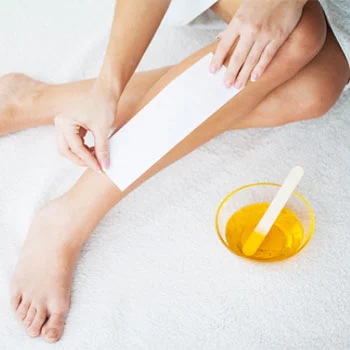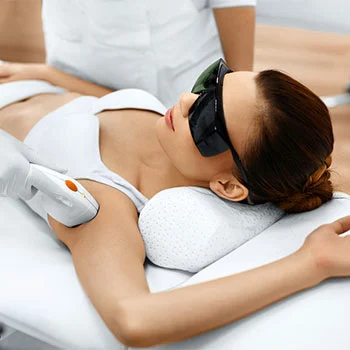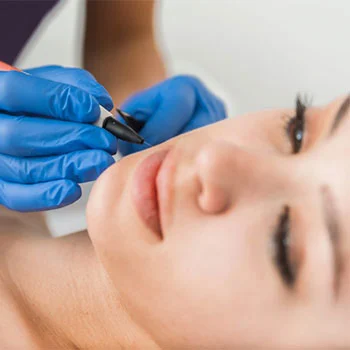What is threading?
Threading is a method of hair removal that originated in Asia and the Middle East. It involves using a twisted cotton thread to quickly and precisely remove unwanted facial and eyebrow hair. The thread is rolled over the hair, catching the hairs in the thread and pulling them out from the follicle. Threading is popular because it is a precise hair removal technique that can create clean lines and shapes, making it ideal for shaping eyebrows. It is also suitable for sensitive skin as it does not involve the use of any chemicals or heat.
Who is threading suitable for?
Threading is suitable for most people looking to remove unwanted facial and eyebrow hair. It is a gentle hair removal method that is suitable for sensitive skin types, as it does not involve the use of chemicals or heat that can irritate the skin. Threading is particularly popular for shaping eyebrows, as it allows for precise hair removal to create clean lines and defined shapes. However, individuals with very sensitive skin, certain skin conditions, or those using certain medications may want to consult with a dermatologist before trying threading to ensure it is suitable for their skin type.
How it’s done
Threading is done using a thin, twisted cotton thread that is doubled and then twisted to create a loop. The esthetician or threading specialist will hold one end of the thread in their teeth and the other in their hand, creating a taut line in the middle. They will then use a twisting motion with their fingers to move the loop of the thread over the unwanted hair, catching the hairs in the loop and pulling them out from the follicle. This process is repeated until the desired area is free of hair. Threading allows for precise hair removal, making it ideal for shaping eyebrows or removing hair on the face.
During a threading appointment, you can expect the following:
- Consultation: The technician will discuss your desired eyebrow shape or area for hair removal.
- Preparation: Your skin will be cleansed, and possibly powdered to help with grip.
- Threading: The technician will use a twisted thread to remove unwanted hair by rolling it over the skin.
- Precision: Threading allows for precise hair removal, shaping, and definition.
- Discomfort: Some discomfort is normal, but it is usually quick and tolerable.
- Aftercare: The technician may apply soothing lotion and provide aftercare instructions.
How to prepare
Before getting threading done, especially for facial hair removal, there are a few things you can do to prepare and ensure a more comfortable and effective experience:
- Allow hair to grow: For threading to be effective, the hair needs to be long enough for the thread to grip onto. It's recommended to let the hair grow out for a few weeks before your threading appointment.
- Exfoliate: Gentle exfoliation a day before threading can help remove dead skin cells and ensure a smoother hair removal process.
- Cleanse your skin: Make sure your skin is clean and free of makeup or lotions before the threading session. This helps prevent irritation and allows for better hair removal.
- Stay hydrated: Keeping your skin well-hydrated can help reduce sensitivity during and after threading.
- Avoid sun exposure: It's best to avoid direct sun exposure or tanning beds before threading, as sunburned or tanned skin can be more sensitive.
- Communicate with the technician: If you have any skin conditions, allergies, or concerns, make sure to communicate them to the threading technician before the session.
- Take pain relief if needed: If you are sensitive to pain, you can consider taking a mild pain reliever like ibuprofen before the session to help reduce discomfort.
- Follow aftercare instructions: After threading, follow any aftercare instructions provided by the technician, such as avoiding harsh skin care products, sun exposure, or excessive touching of the treated area.
By following these preparation tips, you can help ensure a smoother and more comfortable threading experience with better results.
Recovery and aftercare
After getting eyebrow threading done, it's essential to follow proper aftercare to ensure a smooth recovery and maintain the results. Here are some tips for recovery and aftercare following threading:
- Avoid touching the threaded area: It's important to avoid touching or rubbing the threaded area immediately after the procedure to prevent irritation or infection. Touching the area can transfer bacteria from your hands to the freshly threaded skin.
- Apply a soothing gel: You can apply aloe vera gel or a soothing cream to calm the skin and reduce any redness or inflammation. Avoid products with harsh chemicals or fragrances that can irritate the skin.
- Avoid makeup: It's best to avoid applying makeup on the threaded area for at least 24 hours after the threading session. Makeup can clog the hair follicles and lead to breakouts or irritation.
- Avoid direct sunlight: Protect the threaded area from direct sunlight, as exposure to UV rays can cause skin sensitivity and irritation. If you need to go out in the sun, apply sunscreen to protect the skin.
- Avoid exfoliation: Refrain from using harsh exfoliants or scrubs on the threaded area for a few days after the threading session. Exfoliation can further irritate the skin and increase the risk of ingrown hairs.
- Moisturize: Keeping the skin hydrated is essential for promoting healing and maintaining skin health. Use a gentle, non-comedogenic moisturizer to keep the skin hydrated without clogging the pores.
- Avoid swimming or saunas: It's recommended to avoid swimming pools, saunas, or steam rooms for at least 24 hours after threading to prevent bacteria or irritants from coming into contact with the threaded skin.
By following these aftercare tips, you can help promote a smooth recovery after eyebrow threading and maintain the results for longer. If you experience any persistent redness, irritation, or other concerns after threading, it's advisable to consult with a dermatologist for further guidance and treatment.
Eyebrow threading
Eyebrow threading is a popular hair removal technique that has been practiced for centuries, originating in South Asia and the Middle East. It has gained widespread popularity around the world due to its precision and ability to create well-defined and groomed eyebrows.
One of the key advantages of eyebrow threading is its precision. Unlike waxing or tweezing, which can sometimes lead to over-tweezing or uneven shapes, threading allows for more control over the hair removal process. The threading specialist can create sharp and defined eyebrow shapes, tailored to suit the individual's facial features and preferences. This precision makes threading an ideal choice for those looking to achieve perfectly shaped eyebrows.
Another benefit of eyebrow threading is that it is a gentle hair removal method, making it suitable for individuals with sensitive skin. Threading does not involve the use of any chemicals or heat, reducing the risk of skin irritation or allergic reactions. The process is quick and efficient, making it a convenient option for those with busy schedules who want to maintain well-groomed eyebrows.
Eyebrow threading is also known for its long-lasting results. Since threading removes hair from the root, it takes longer for the hair to grow back compared to other methods like shaving or depilatory creams. This means that individuals can enjoy well-shaped eyebrows for an extended period before needing another threading session.
Threading side effects
Threading is generally considered a safe method of hair removal, but like any hair removal technique, it can have some side effects for some individuals. Some possible side effects of threading may include:
- Redness: It is common to experience mild redness or irritation in the threaded area immediately after the procedure. This usually subsides within a few hours.
- Sensitivity: Some people may experience increased sensitivity in the threaded area, especially if they have sensitive skin.
- Pain: Threading can be uncomfortable or painful, especially for those with a lower pain tolerance or when removing hair from sensitive areas.
- Ingrown hairs: Improper threading technique or aftercare can lead to ingrown hairs, where the hair curls back into the skin instead of growing out.
- Allergic reactions: In rare cases, individuals may experience allergic reactions to the threading thread or products used during the procedure.
To minimize the risk of side effects, it's essential to go to a reputable and experienced threading specialist, follow proper aftercare instructions (such as avoiding touching the threaded area, applying soothing products, and avoiding direct sunlight), and communicate any skin concerns or sensitivities beforehand.
How much does threading cost?
The cost of threading can vary depending on several factors such as the location, the expertise of the threading specialist, and the area being treated. On average, threading typically costs between $10 and $30 per session for eyebrows. Pricing may also vary for other facial areas or full-face threading.
It's essential to research local salons or threading specialists in your area to get an accurate idea of pricing. Some salons may offer package deals or discounts for multiple sessions, so it's worth inquiring about any promotions that may be available.
Threading vs. waxing: which is right for me?
Threading and waxing are both popular hair removal techniques, but they have some differences that can make one more suitable in different situations. When deciding between threading and waxing for hair removal, there are a few factors to consider:
Threading
- Ideal for those with sensitive skin.
- Precise method for shaping eyebrows and removing facial hair.
- Does not involve the use of chemicals or heat.
- Can be more painful for some individuals, especially in sensitive areas.
Waxing
- Efficient for larger areas like legs, arms, and back.
- Provides longer-lasting results compared to threading.
- Can cause some discomfort during the process.
- Not recommended for sensitive skin or certain skin conditions.
Ultimately, the right choice depends on your skin type, the area you want to treat, and your pain tolerance. If you have sensitive skin or want precise hair removal for areas like the eyebrows, threading may be the better option. However, if you are looking for a quick method for larger areas and don't have sensitive skin, waxing may be more suitable. It's a good idea to try both methods and see which one works best for you based on your preferences and your skin's reaction.
FAQs
Can I get my body hair threaded?
Yes, you can get your body hair threaded, although threading is more commonly used for facial hair removal. It can be used on other parts of the body as well, but it may be more time-consuming compared to other hair removal methods like waxing.
Does threading remove hair permanently?
No, threading does not remove hair permanently; it typically lasts 4-6 weeks before regrowth.
Is it possible to thread one’s own eyebrows?
It is possible to thread your own eyebrows, but it requires practice and skill to achieve desired results.
Is threading painful?
Threading can be slightly painful, but the discomfort is usually brief and tolerable for most people.
How long does a threading session last?
A threading session typically lasts between 15 to 30 minutes, depending on the area being threaded and the individual's hair growth and desired results. Eyebrow threading, for example, can be completed within 10-15 minutes, while threading larger areas like the full face may take longer.



